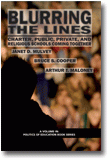
Blurring The Lines
Charter, Public, Private and Religious Schools Come Together
By:
Janet D. Mulvey
Bruce S. Cooper, Fordham University
Arthur T. Maloney
A volume in the series: Politics of Education Book Series. Editor(s): Lora Cohen-Vogel. Bruce S. Cooper, Fordham University. Bonnie Fusarelli, North Carolina State University.
Published 2010
This book, Blurring the Lines, has immediate appeal to policy-makers, and analysis in public and private sectors, as well as legal scholars and practitioners. It will be of interest, too, to university teachers working in the areas of "School Law," "School Policy and Politics," and "New Trends in American K-12 Education." The book treats the complex and interesting issues of Church-State and Public-Private education, the two great changing cross-road in US education.
CONTENTS
1. Public Purposes, Private and Religious Methods: Past to Present. 2. Blurring Everywhere: Cases in Point. 3. Catholic-Related Charter Schools: Supporting Parish Schools for Survival. 4. Florida Hebrew Charter School Challenges the Boundaries: The Ben Gamla School. 5. Minnesota Islamic Charter School Blurs the Line: The Case of the Tarek ibn Ziyad Academy (TiZA) Thomas Maeglin. 6. Ethnically-Based Charter Schools and Racial Separation: The Aims of Education. 7. Protestants, Evangelicals and the Charter School Movement. 8. The Orthodox Jewish Community: Kiryas Joel Union Free School District. 9. Faith and Education: Implications for Public Policy. 10. Where to Now? Clearer or Blurrier? Implications for the Future
REVIEWS
" With the rise of religiously-affiliated charter schools hither and yon, the line separating secular and sectarian education is increasingly murky. Are these schools a beachhead for valuable cultural, linguistic, and ethnic learning? Or are they a backdoor entry into state-sponsored religion? This thoughtful book explores this complex terrain and emerges with a rather cloudy answer: “The combination of dramatic public policy initiatives proclaiming charter schools as the answer to genuine school reform, relaxed public attitudes to the separation issue, and apparent judicial confusion regarding the wall of separation have left us with standards which are barely discernable.†To prove their point, the authors offer case studies of a Catholic charter school that rents space from the local archdiocese, a Hebrew charter school that offers a “modern Jewish education,†and another with an Islamic dress code. Stepping away from sectarian schools, the authors also question ethnically-based charter schools. Is a charter school that teaches Arabic culture, including the Qu’ran, too religious? What about one that uses the Bible as a key text? Debates over religious instruction in public schools have raged pretty much since Horace Mann; this book further stokes that fiery conversation." Daniela Fairchild Thomas B. Fordham Institute in Education Gadfly
-
Paperback978-1-61735-144-0
Web price: $45.04 (Reg. 52.99)
-
Hardcover978-1-61735-145-7
Web price: $80.74 (Reg. 94.99)
- eBook9781617351464

- EDU029000 - EDUCATION: TEACHING METHODS & MATERIALS: General
- EDU037000 - EDUCATION: Research
- EDU001000 - EDUCATION: ADMINISTRATION: General
-
 (Re)Envisioning Social Studies Education Research
Current Epistemological and Methodological Expansions, Deconstructions, and Creations
(Re)Envisioning Social Studies Education Research
Current Epistemological and Methodological Expansions, Deconstructions, and Creations
-
 Cultivating Democratic Literacy Through the Arts
Guiding Preservice Teachers Towards Innovative Learning Spaces in ELA Classrooms
Cultivating Democratic Literacy Through the Arts
Guiding Preservice Teachers Towards Innovative Learning Spaces in ELA Classrooms
-
 Distance Learning
Volume 20 #4
Distance Learning
Volume 20 #4
-
 Diversity as Strategic Opportunity
Exploring New Paths to Good Administration
Diversity as Strategic Opportunity
Exploring New Paths to Good Administration
-
 Frameworks for Integrated Project-Based Instruction in STEM Disciplines
Frameworks for Integrated Project-Based Instruction in STEM Disciplines
-
 Qualitative Research With Diverse and Underserved Communities
Qualitative Research With Diverse and Underserved Communities
-
 Supporting Leaders for School Improvement Through Self-Care and Wellbeing
Supporting Leaders for School Improvement Through Self-Care and Wellbeing

